I and three of my colleagues have written a commentary (Radun et al., 2019) about a widely quoted statistic regarding the health benefits of cycling (BMA, 1992; Hillman 1992, 1993) that we believed is misleading. Our review of the source material identified no supporting data or analysis for this statistic. Our paper still remains a preprint because… more about it in my oncoming text.
In this blog text, I list a number of uncritical citations of the alleged 20:1 ratio. As you will see, not only the ratio was uncritically cited in scientific papers, blogs, Wikipedia, it has also been used in public policy discussions. Please note this is not a shaming list… I make it to strengthen our article.
(Peer-reviewed) articles
| de Jong, in an assessment of the societal health benefit of bicycle helmet laws, used the 20:1 ratio as a reference point. We mentioned this citation in our paper because de Jong’s paper has been rather influential. | 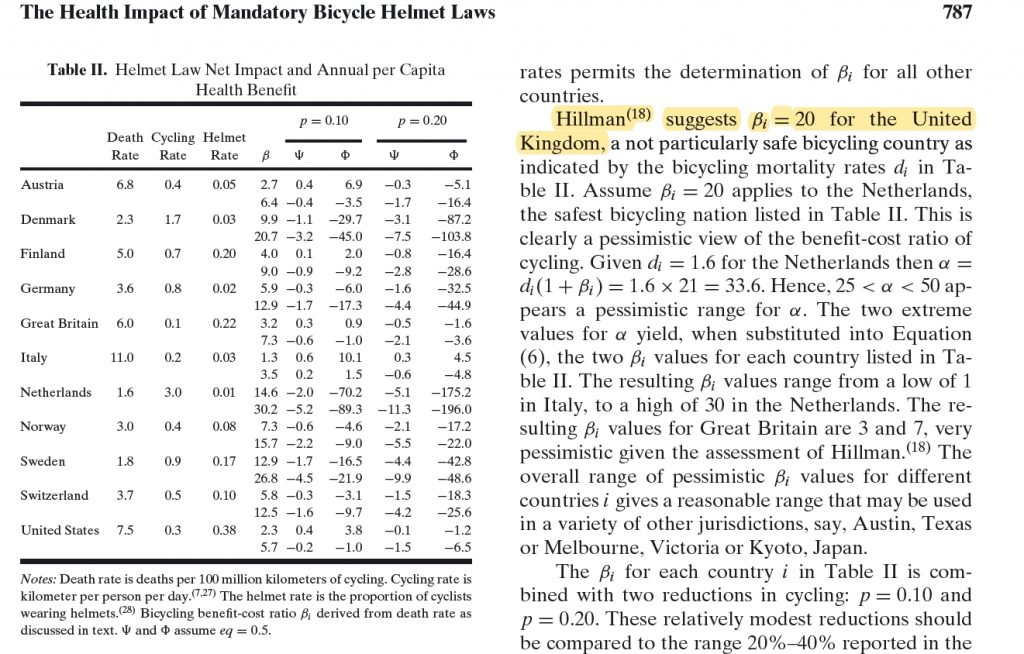 |
| Dorothy Robinson mentions the 20:1 ratio in the abstract of her paper opposing helmet legislation. Moreover, she cites another Hillman’s paper in which he refers to the conference proceedings paper as a source for the 20:1 ratio. So this represents the second-hand citation of the alleged finding. | 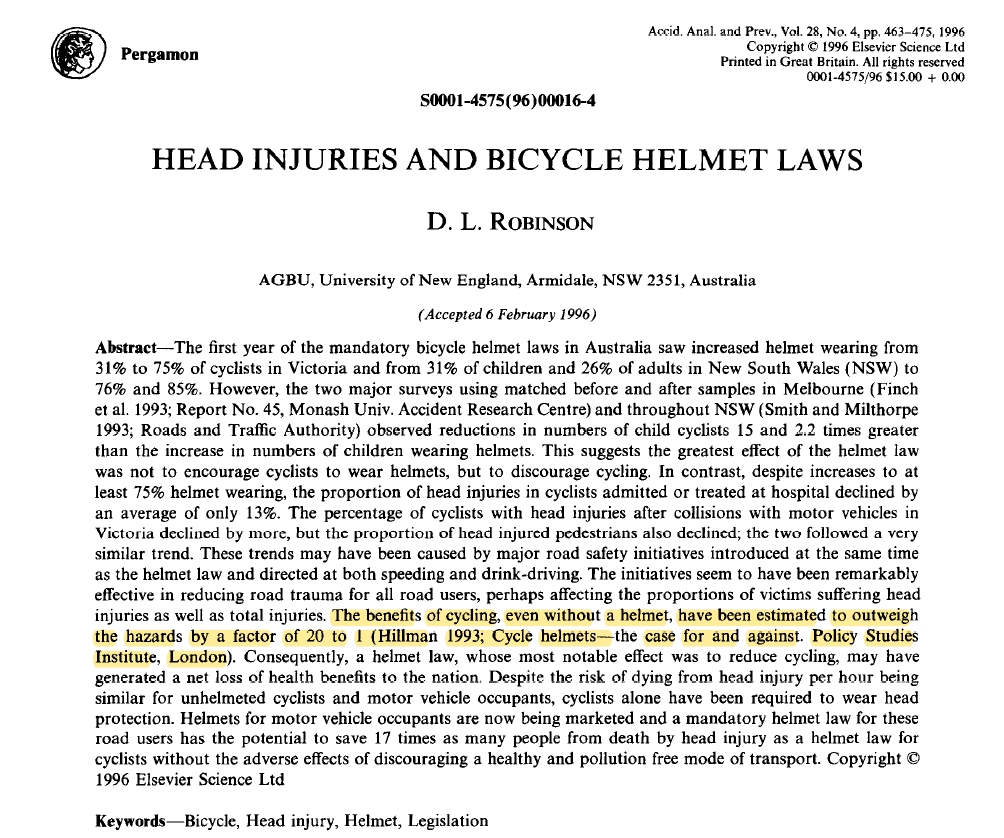 |
| Adams and Hillman in their famous commentary “The risk compensation theory and bicycle helmets.” Please note that this publication is a commentary, not an empirical study as many imply. It is not even a review. |  |
| Kay Teschke et al. mentioned the alleged 20:1 ratio in their paper “Bicycling: Health Risk or Benefit?“ |  |
| Rachel Aldred cites the alleged 20:1 ratio in her paper “Cycling near misses: Their frequency, impact, and prevention.” This is somewhat neutral citation because Aldred writes “An oft-quoted, albeit questionable (Woodcock et al., 2014) statistic suggests health benefits outweigh risks to the individual by 20–1 (Hillman, 1993).” However, I was not able to find anything about the alleged ratio in Woodcock et al., 2014. |  |
| Colin F Clarke cites the alleged 20:1 ratio in his paper “Evaluation of New Zealand’s bicycle helmet law.” As Robinson, Clarke cites the alleged finding in the abstract. | 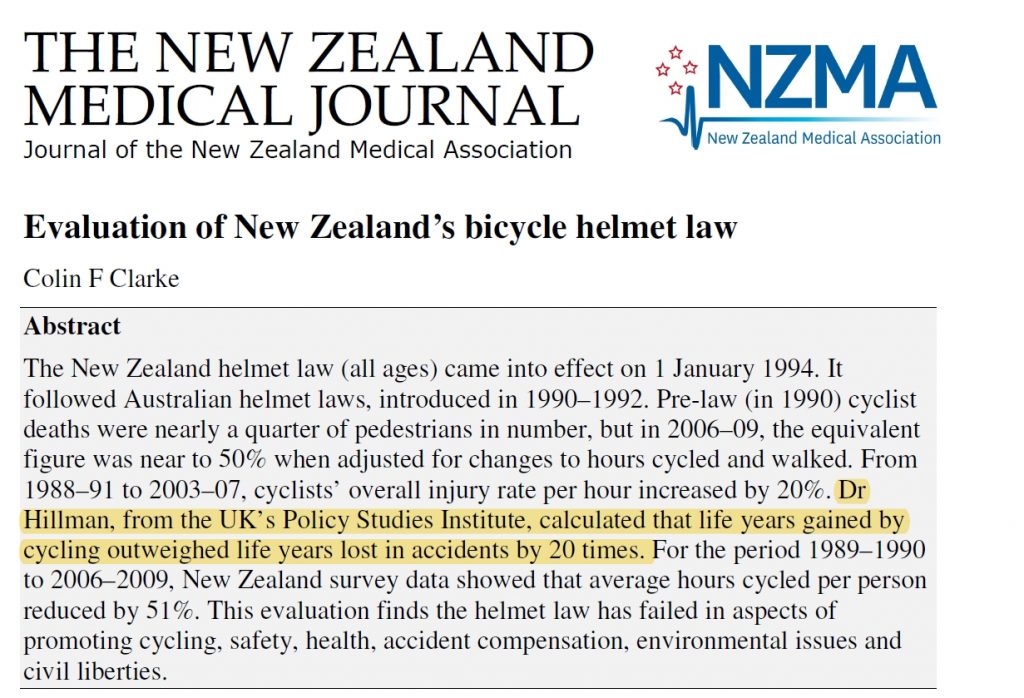 |
| Thomas J. De Marco in his article “The use of bicycle helmets should not be mandatory.“ |  |
| Joerg Schweizera & Federico Rupia in their paper “Performance evaluation of extreme bicycle scenarios“ |  |
| Lovelace R, Roberts H, and Kellar I in their article “Who, where, when: the demographic and geographic distribution of bicycle crashes in West Yorkshire“ | 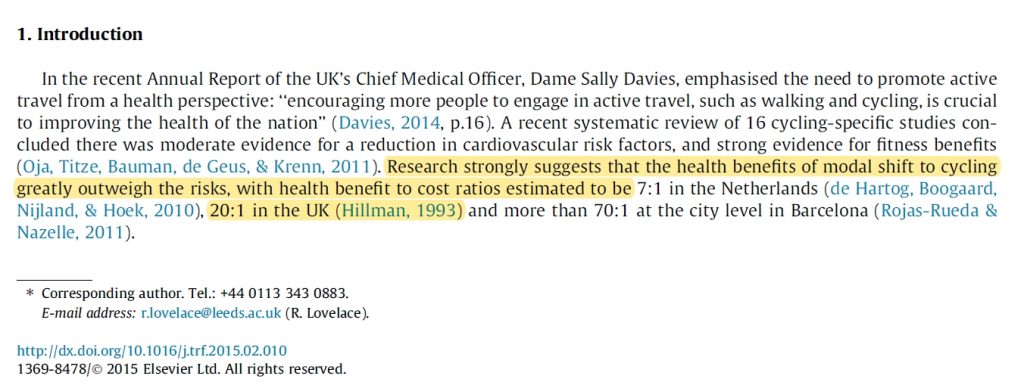 |
| Rony Blank-Gomel in “Re-assembling automobility: bicycle helmets and the risks of cycling in the US, 1970-1995“ |
 |
| Kathryn Stewart, Transport Research Institute, Edinburgh Napier University, United Kingdom Adrian McHale, RPS Group, Newark, United Kingdom |
 |
| “Bicycling and Transportation Demand Management“ By Todd Litman In TRANSPORTATION RESEARCH RECORD 1441 |
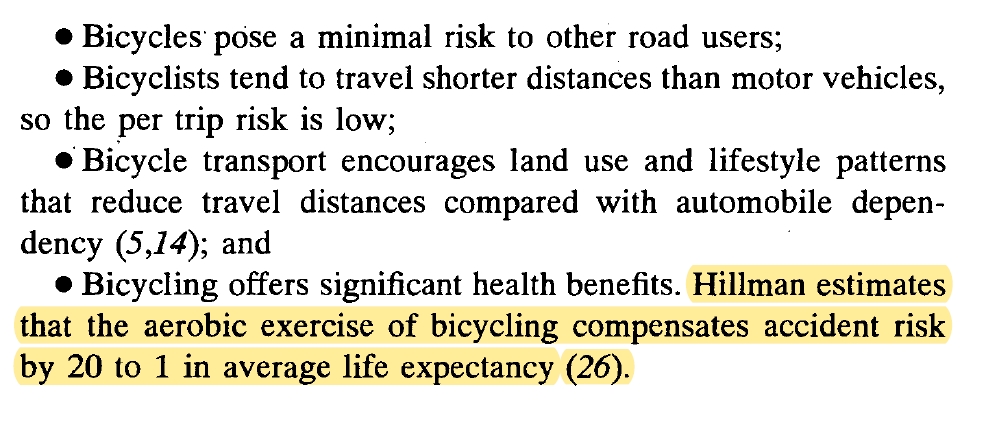 |
| Greg Smith in “Cars Crush Cycling: How hegemonic motor culture prevents rational choice in urban transport.” for Electronic Journal: Social Issues |
 |
| Colin Clarke in his text “The case against bicycle helmets and legislation“ |  |
| Carwyn Hooper and John Spicer in their “Liberty or death; don’t tread on me” in Journal of Medical Ethics |  |
| Annie Elkins in her paper “On your bike!” cites Cavill N, Davis A. Cycling & Health. What’s the evidence? European Cyclists Federation; 2007. as the source for the alleged 20:1 ratio. |
 |
| This one is also very interesting. “The most thorough effort…” Conor C.O. Reynolds, Meghan Winters, Francis J. Ries, Brian Gouge |
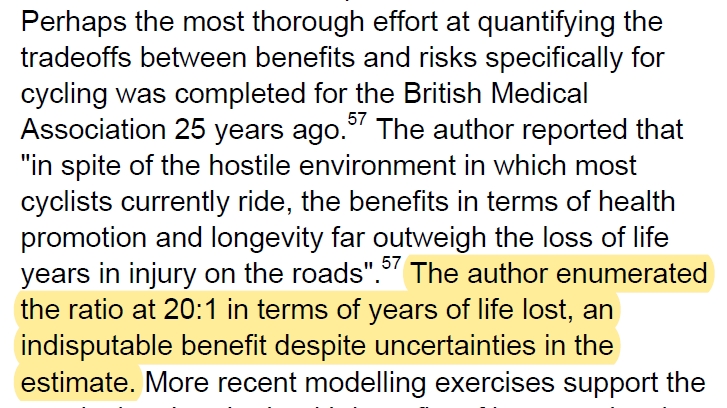 |
| David Pimente in “Cycling, Safety, And Victim-Blaming: Toward A Coherent Public Policy For Bicycling In 21st Century America“ |  |
| Dorothy Robinson in another opinion paper about helmet laws. |  |
| John Pucher: “The role of public policies in promoting the safety, convenience & popularity of bicycling“ | 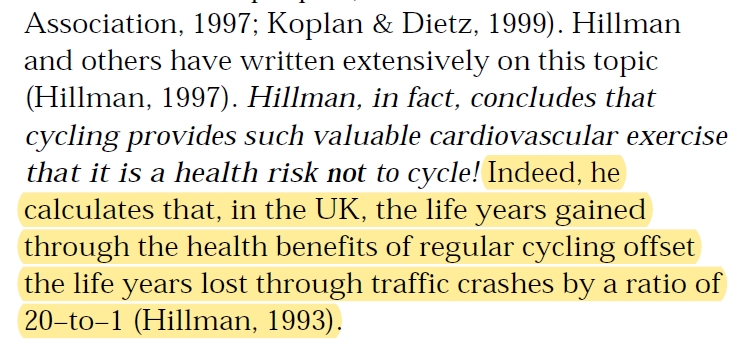 |
| Francesca Racioppi, Carlos Dora and Harry Rutter: “Urban Settings and Opportunities for Healthy Lifestyles: Rediscovering Walking and Cycling and Understanding Their Health Benefits“ | 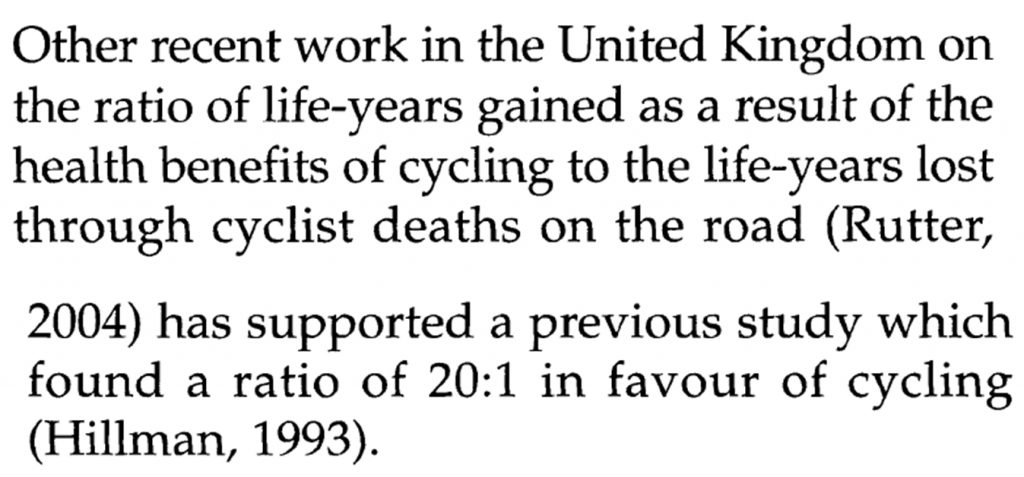 |
| more | to come |
| more | to come |
| more | to come |
| more | to come |
| more | to come |
| more | to come |
| more | to come |
| more | to come |
| more | to come |
| more | to come |
| more | to come |
| more | to come |
| more | to come |
Public policy discussions
| Chris Rissel cited the alleged 20:1 ratio in his response to the Australian Senate Standing Committee on Economics inquiry into Personal Choices and Community Impact regarding bicycle helmet laws. |  |
| Mayer Hillman cites himself in his statement submitted to a Northern Ireland Committee for the Environment Report, where the focus was on Cyclists (Protective Headgear). | 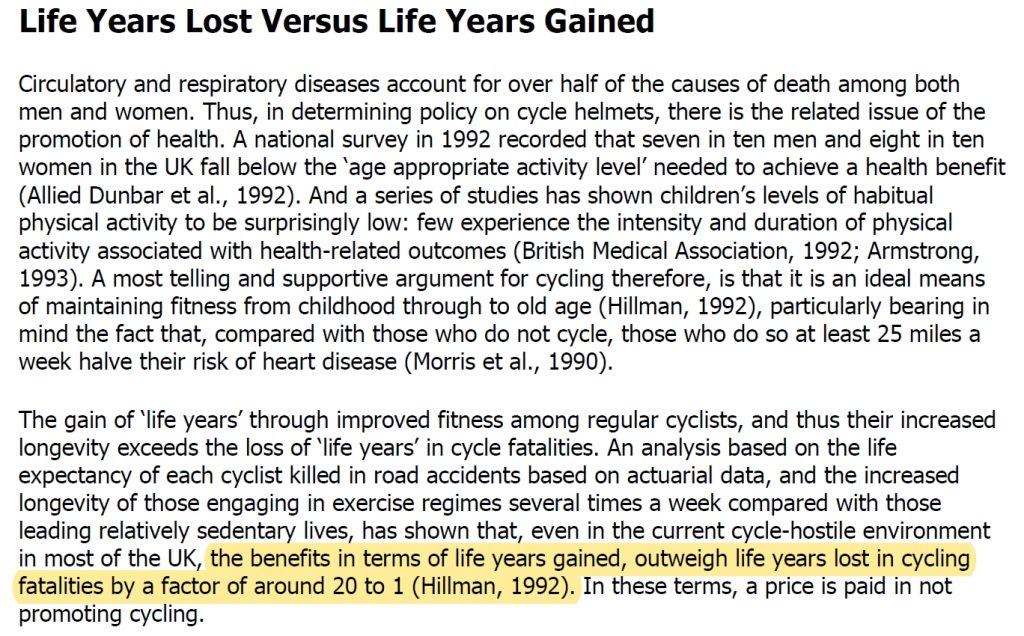 |
| The Finnish Cyclists’ Federation uses it in their argument to repeal an existing bicycle helmet law. Their text is in Finnish and here is my unofficial translation: “The helmet use regulation provides an image of cycling as a particularly risky activity, which reduces the attractiveness of cycling. However, cycling is not particularly dangerous compared to, for example, pedestrians, and because of the health benefits as it has been shown the benefits of cycling exceed the risks 20 times [Hillman M. Cycling and the Promotion of Health. Policy Studies Vol. 14, 49-58, 1993).” |  |
| Dr Nigel Perry’s submission to Australia’s Senate Economics References Committee. |  |
| CTC the national cyclists’ organisation in their submission to the UK Parliament committee. |  |
| Jim Pravetz in “Review of Bicycle Policy and Planning Developments in Western Europe and North America” for Office of Transport Policy and Planning Government of South Australia |
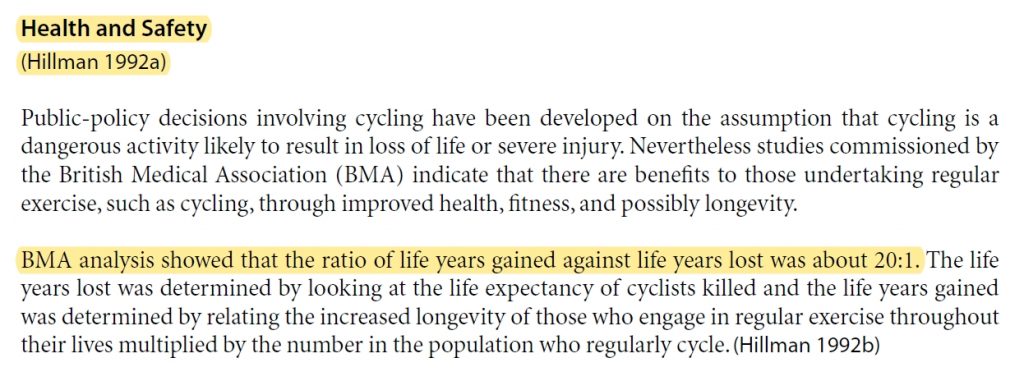 |
| The alleged 20:1 ratio found its place even in WHO publication. Transport, environment and health / edited by Carlos Dora and Margaret Phillips |  |
| British Medical Association in their “Healthy transport = Healthy lives” |  |
| POLIS – European Cities and Regions networking for innovative transport solution and EUROCITIES in their “MANUAL INCLUDING THEMATIC GUIDELINES AND HANDBOOK FOR LOCAL CAMPAIGNERS“ |  |
| Submission to the Western Australian Parliamentary Inquiry on Personal Choice and Community Safety Topic: mandatory bicycle helmet laws by Dr. Sundance Bilson-Thompson October 5, 2018 |
 |
| Prof Chris Oliver in his opinion piece submitted to Australian Bicycle Network regarding their Mandatory Helmet Review. |  |
| Chris Gillham, owner of http://cycle-helmets.com in his opinion piece submitted to Australian Bicycle Network regarding their Mandatory Helmet Review. |
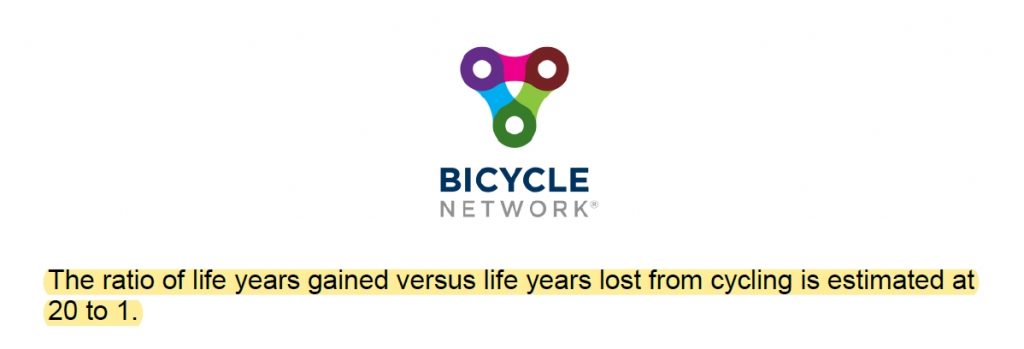 |
| James Steward in his opinion piece submitted to Australian Bicycle Network regarding their Mandatory Helmet Review. |  |
| European Commission cites ECF’s publication as a source for the 20:1 ratio. |  |
| The alleged 20:1 ratio is so widely accepted… that no citation is needed. Brighton & Hove City council-> |
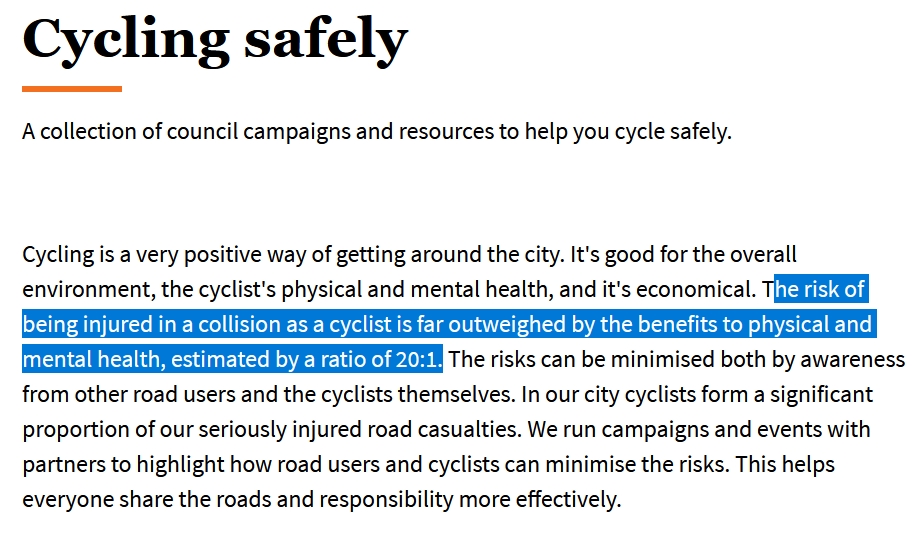 |
| Phillip Jacobs to the members of the Slovenian Parliament |  |
| The Department of Health and Department for Transport have jointly published a new Active Travel Strategy |  |
| “Raising the Profile of Walking and Cycling in New Zealand was produced by the Ministry of Transport in association with Brunton Grant Consulting.” |  |
| Somerset Future Transport Plan (FTP). Cycling strategy | 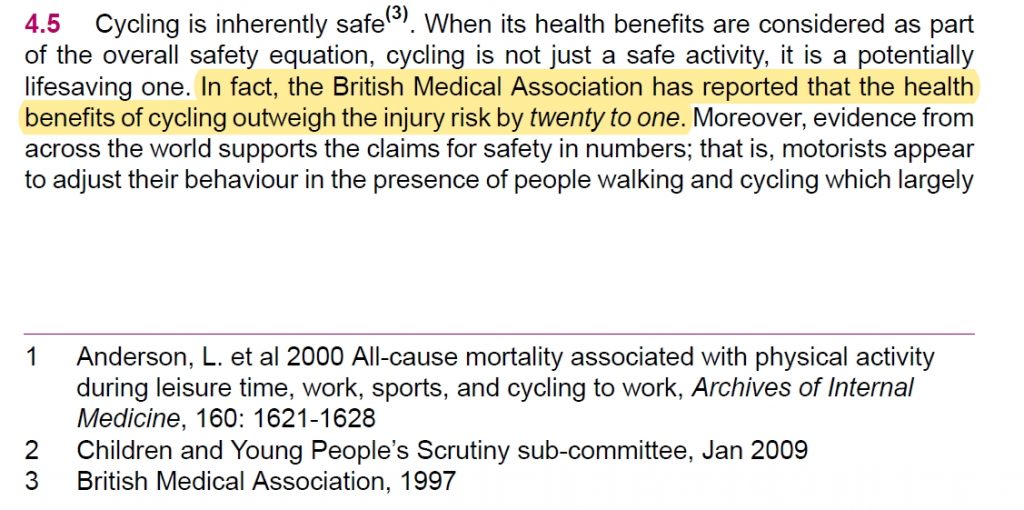 |
| Catriona O’Dolan and Kathryn Stewart, Transport Research Institute, Edinburgh Napier University, and Reggie Tricker, Edinburgh City Council in their “Evaluating the Impact of Innovative Cycling Measures in EU cycling cities“ |  |
| This is in Polish. Google translates “Studies show that the years of life gained from cycling outweigh the years lost due to accidents by a ratio of 20: 1.” MP Józef Lassota to the minister of justice. |
 |
| Achieving a Cycling-Friendly Ireland A National Cycling Promotion Policy |
 |
| Something in Serbo-Croatian language from Bosnia and Herzegovina. Those (Center for Environment) were lobbying for the helmet law repeal: |  |
| Trent Piepho during King county board of health meeting proceedings, May 16, 2003, King County Council Chamber about Bicycle Helmets |
 |
| Scottish Forum For Public Health Medicine in their “Health Related Physical Activity” |  |
| Colin Clarke in his Submission to the Parliament of Victoria March 2013 Road Safety Committee – Inquiry into serious injury in motor vehicle accidents |  |
| Joyce et al. Best Practices in State Bicycle and Pedestrian Planning: A Guide for Plan Preparation |  |
| “Pedestrian and Bicycle Facilities” Transportation Research Board, 2003 |  |
| more | to come |
| more | to come |
| more | to come |
| more | to come |
Books, master thesis etc.
| Chris Rissel in a book chapter “Health benefits of cycling.” The book is “Cycling futures.” |  |
| Dave Horton in a book chapter “Fear of Cycling.” The book is “Cycling and Society” edited by Dave Horton, Paul Rosen, Peter Cox |
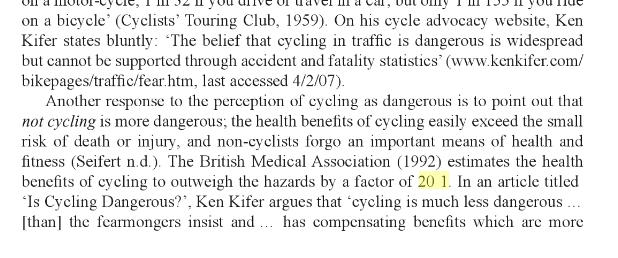 |
| Walkable City: How Downtown Can Save America, One Step at a Time By Jeff Speck |
 |
| “How to Live Dangerously: The Hazards of Helmets, the Benefits of Bacteria, and the Risks of Living Too Safe” by Warwick Cairns |
 |
| Richard Burton in MSc thesis “Do cyclists have an exaggerated perception of the effectiveness of cycle helmets and the risks of cycling?” Transport Planning at the University of the West of England, Bristol. |
 |
| Cecilie Buch Thomsen in her thesis “Can Denmark Teach the World How to Ride a Bike?“ |  |
| The Transportation Research Board in their “Traveler Response to Transportation System Changes, Part 16“ |  |
| Ken Spence in a book “Sustainable Transport” edited by R Tolley |
 |
| A Davis, N Cavill, M Wardlaw, J Mindell in “Physical Activity, Trends in Walking & Cycling & the Obesity Epidemic.”They are all (except Cavill) from Transport and Health Science Group (“opposes cycle helmet legislation”) & involved as editors/board members in JTH which rejected our paper;-) |
 |
| Hildegard Resinger and Haritz Ferrando in “Do Cyclists Need Mandatory Helmets?“ |  |
| “Everything Under the Sun: Toward a Brighter Future on a Small Blue Planet” By David Suzuki, Ian Hanington | 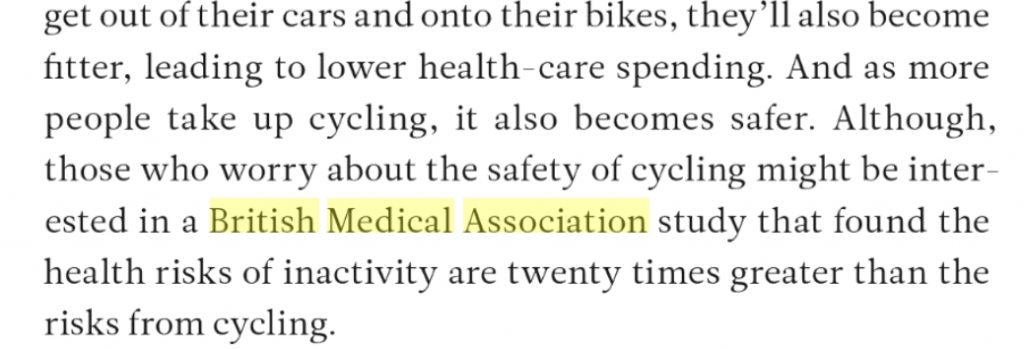 |
| David Suzuki & Ian Hanington in a book “Just Cool It!: The Climate Crisis and What We Can Do – A Post-Paris Agreement Game” the same text appeared in their book “Everything Under the Sun: Toward a Brighter Future on a Small Blue Planet” I already cited. |
 |
| Master thesis “Planning the Last-Mile: Improving urban freight delivery using cyclelogistics” by Dennis Aaron Dixon Vancouver Island University |
 |
| “Bicycle Crashes in New Zealand” by Kerry Wood |  |
| C. Banwell et al., Weight of Modernity: An Intergenerational Study of the Rise of Obesity |  |
| “Are you a cyclist or do you cycle? The language of promoting cycling” by Glen Koorey |  |
| Johnson, M (2011). Cyclist safety: an investigation of how cyclists and drivers interact on the roads. PhD thesis, Monash University. |  |
| Paul Tranter & Rodney Tolley in Slow Cities: Conquering our Speed Addiction for Health and Sustainability |  |
| Tomorrow’s World: Britain’s Share in a Sustainable Future By Duncan McLaren, Simon Bullock, Nusrat Yousuf | 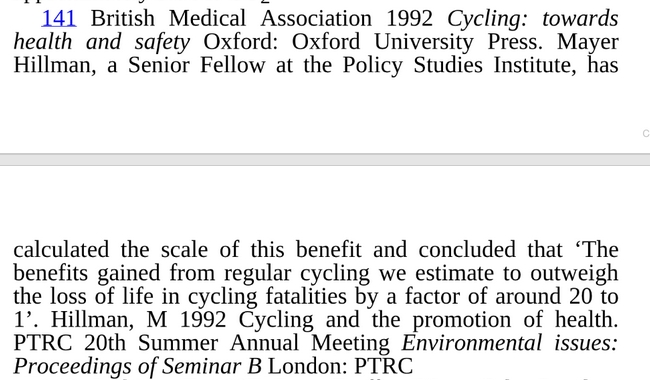 |
| Encyclopedia of Environmental Health |  |
| Rony Blank-Gomel copy/paste the text from his article (see above) into his doctoral thesis |  |
| more | to come |
| more | to come |
| more | to come |
Wikipedia, blogs, newspapers etc.
| Of course, the ratio has found its place in Wikipedia |  |
| Moving Beyond Zero have the alleged 20:1 ration on their front page. |  |
| The European Cyclists’ Federation cite the alleged 20:1 ratio in their Helmet factsheet. |  |
| Dorothy Robinson for http://cyclehelmets.org in her paper “Helmet Laws: creating consensus from controversy and contradictions.“ |  |
| Adrian Davis and Nick Antony Cavill in “Cycling and Health; What’s the evidence?“ |  |
| This is tragicomic: anti-helmet (law)? people who were editing Wikipedia pages about bicycle helmets didn’t find Hillman’s 20:1 ratio good enough for Wikipedia, while a number of researchers cite this ratio in their scientific publications. | 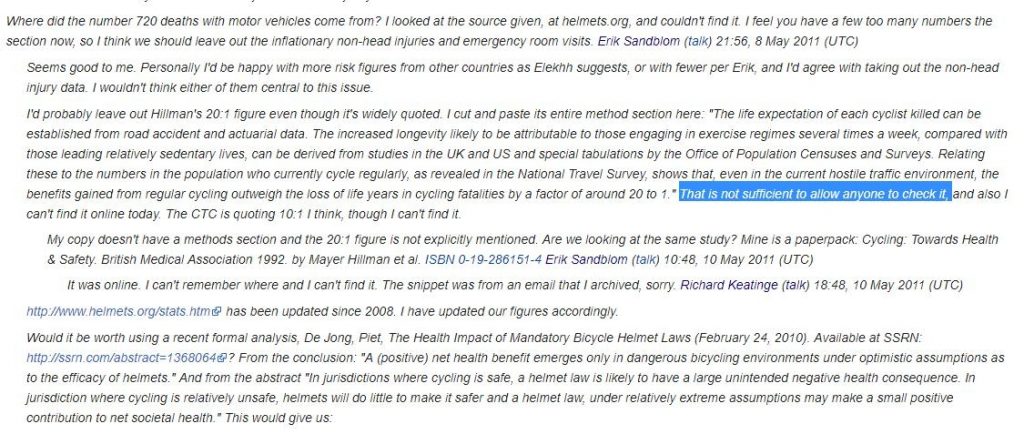 |
| BMJ published an opinion piece in which the author writes: “Overall, people get an estimated 20:1 life years gained due to the benefits of cycling versus life years lost through injuries.” & cites Cycling UK brochure as a source |
 |
| Cycling UK in their “Cycle helmets: An overview of the evidence.“ |  |
| BBC |  |
| Article “A chain reaction” in the Guardian. | 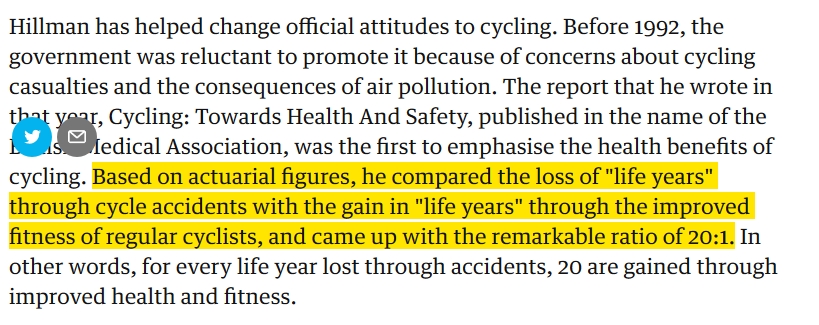 |
| The Irish Cycling Advocacy Network (ICAN) in their press release “COUNTER-PRODUCTIVE RSA CAMPAIGN A ‘RED HERRING’, SAY CYCLISTS, BECAUSE IT SCAREMONGERS ABOUT THE RISKS IN CYCLING” | 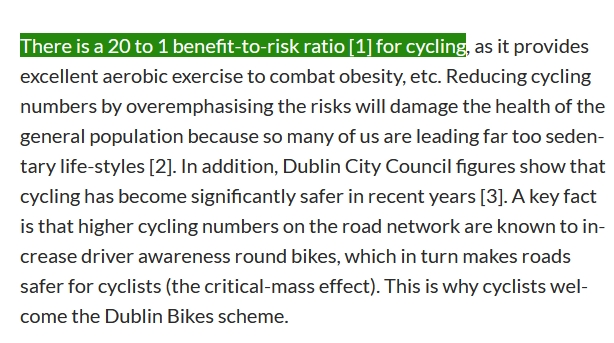 |
| A blog written by a board member of the Finnish Cyclists’ Federation (Pyöräliitto) also cited the alleged 20:1 ratio. |  |
| Novonordisk in their “Triple Bottom Line approach to business” magazine. | 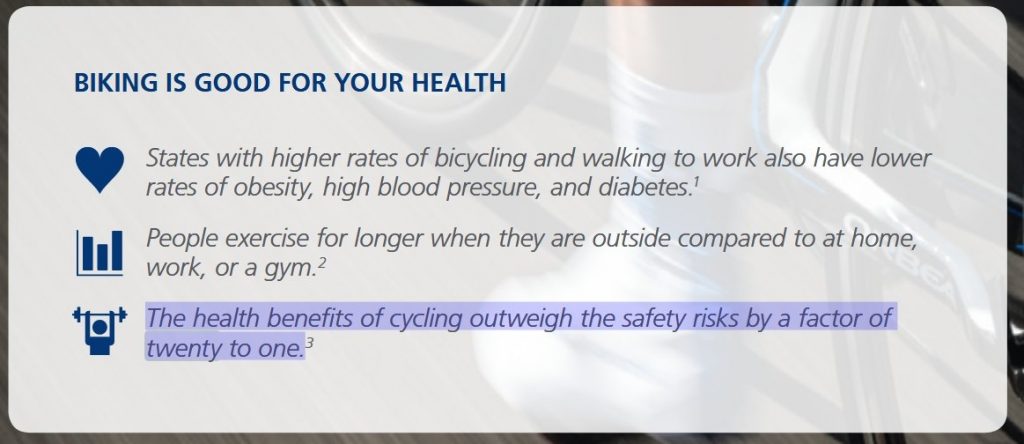 |
| Here we have something in Swedish. “Den byggda miljöns påverkan på fysisk aktivitet.“ |  |
| C40 (a network of the world’s megacities committed to addressing climate change) in their “Benefits of Climate Action“ | 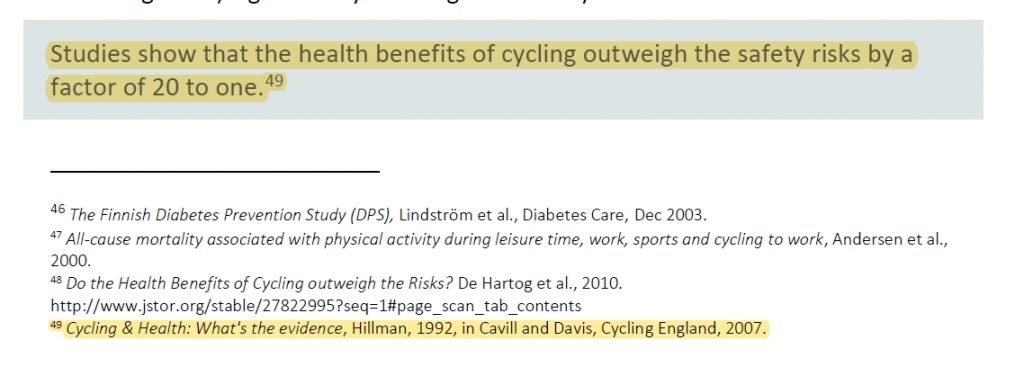 |
| The ratio appears in so many blogs. This blog of the Washington Area Bicyclist Association uses a second-hand citation. |  |
| Luke Turner “Member of Helmet Freedom (http://helmetfreedom.org) and a former investment banker” in his text “Australia’s helmet law disaster” |  |
| “The figure most often quoted is 20:1…” Cambridge Cycling Campaign are absolutely right about that! |
 |
| Hillman cites himself in his Keynote address for MAKING CYCLING VIABLE, New Zealand Cycling Symposium 2000: 14-15 July 2000, 24/7/2000 |  |
| Paul Foster “Misreading hazards” Daily Telegraph Connected 13 March 1998 |  |
| The official account of British Cycling with 173.8K followers. That’s how “the truth” gets spread. |  |
| more | to come |